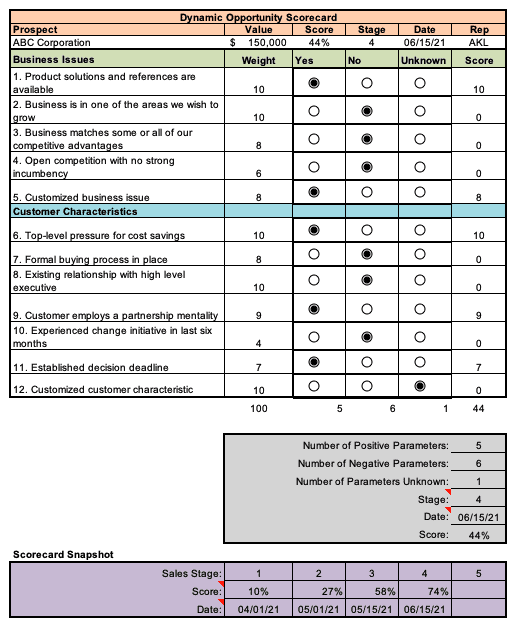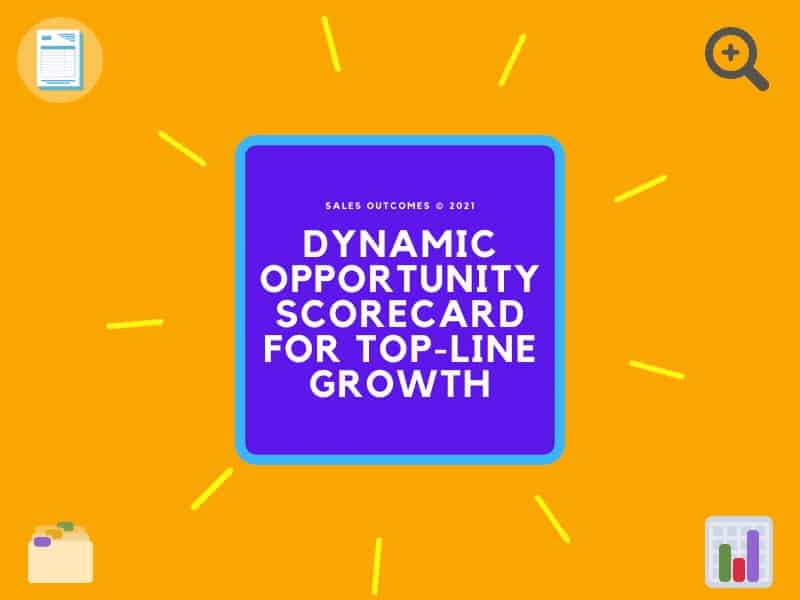Dynamic Opportunity Scorecard FAQs
-
- Why use a Dynamic Opportunity Scorecard?
- What is the Dynamic Opportunity Scorecard?
- What are the Outcomes of the Opportunity Scorecard?
- What does a Dynamic Opportunity Scorecard look like?
A Dynamic Opportunity Scorecard is a powerful tool for sales organizations that struggle with Opportunity qualification, unacceptable win rates, and constrained sales support resources.
Combining the Dynamic Opportunity Scorecard with the question “Did the customer tell you that?” will help improve Opportunity qualification and the organization’s win rate.
1. Why use a Dynamic Opportunity Scorecard?
It enforces a winning sales approach, formalizes an essential step of a sales process, and identifies opportunities that positively align with helping you win. The Dynamic element reflects that the scorecard changes as the pursuit team knows more about the opportunity.
2. What is the Dynamic Opportunity Scorecard?
- It’s no more than 20 opportunity attributes that influence deal success and enable evaluation (and reassessment) of deal potential as the sales cycle progresses.
- It clarifies a salesperson’s instinct about an Opportunity versus information about an Opportunity.
- Understanding the Opportunity score relative to other potential opportunities in the pipeline allows for intelligent decision-making regarding allocating scarce sales support resources.
3. What are the Outcomes of the Opportunity Scorecard?
- It’s the first step in prescreening opportunities for a potential fit. It isn’t a go-no-go filter; instead, it’s an objective view of the opportunity starting point.
- Provides a guide for the sales team of the critical information they must obtain from the customer or prospect to get the score to improve.
- As the opportunity progresses, sales leaders and support teams can decide how best to allocate resources.
- The pursuit team can disqualify opportunities with low scores in favor of pursuing high-scoring opportunities more aggressively.
- This approach improves sales results based on proven success factors from past successful opportunities.
4. What does a Dynamic Opportunity Scorecard look like?
The image below is an “old school” spreadsheet version, although most companies we work with have the Opportunity Scorecard embedded into their CRM. The score changes as sales teams validate information about the customer and opportunity.
Building the Opportunity Scorecard questions, score parameters, and weighting are best developed with sales and sales support teams in a workshop setting. At that point, the Scorecard is straightforward to deploy as a pilot and then eventually to the entire sales team.

The Dynamic Opportunity Scorecard is not a substitute for insight and judgment, but it can help the sales leadership, the sales support organization, and salespeople see things more objectively.
If you’d like to schedule time with me to know more about how a Dynamic Opportunity Scorecard can help your organization, click here.





